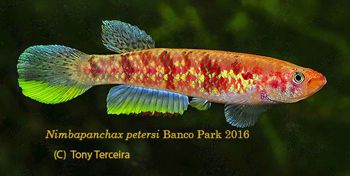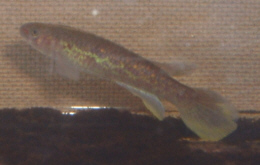Nimbapanchax petersi (Sauvage 1882)

Banco Park
Photo: Courtesy of Ed Pürzl.
| Meaning of Name |
After Dr. Friedrich Wilhelm Peters, a Prussian ichthyologist. | ||||||
| First Description |
Sauvage H.M.E. 1882. Notice sur les poissons du territoire d'Assinie (Cote d'Or)(Mission scientifique de M.Chaper). Bulletin de la Société Zoologique de France 7: p 324-325, plate 5, figure 6. | ||||||
| Size |
5.5 cm (Boulenger 1915) | ||||||
| Meristics |
Boulenger in 'Catalogue of Freshwater Fishes in the British Museum (Natural History)' states that the lateral line pits were 'feebly marked'. Also, Pellegrin advised Boulenger that the number of dorsal rays were incorrectly given by Sauvage in the original description. | ||||||
| Karyotype |
n = 20, A = 28 (Scheel 1974) | ||||||
| Sub-Genus |
| ||||||
| Group |
petersi | ||||||
| Synonyms |
| ||||||
Populations
|
Couacrou (Kouakoukrou) - See next subheading for type locality information. Collected by Sauvage in 1882. Djigbe Forest - Collected by Gras in 1961. Dunkwa - Collected by Spurell in (or before) 1882. Misahoke - Collected by Keilhack in 1910. | ||||||
| Type Locality |
Boulenger in 'Catalogue of Freshwater Fishes in the British Museum (Natural History)' quotes type specimens 1-9 donated by Dr. H.G.F.Spurrell caught at Dunkwa, Gold Coast. These specimens being deposited in the Paris Museum. Wildekamp in 'A World of Killies Vol I' states Couacrou (present day Kouakoukrou, Ivory Coast). At the time of the original description this location was inside the borders of Ghana. In BKA newsletter No.70, June 1971 David Blair quotes the source of Sauvage's type specimens to come from Assinia, a vague coastal locality near the Ghana/Ivory Coast border. | ||||||
| Distribution |
Coastal rainforest areas of southern Ivory Coast & southwestern Ghana on sedimentary soils. | ||||||
| Habitat |
A species which inhabits shallow areas of streams, brooks,
swamps & pools. They have even been caught in small areas of water made by
animal footprints. | ||||||
| Distinguishing Characteristics | |||||||
| Colour/Pattern Variability | |||||||
| History |
Originally described as Haplochilus petersii by Sauvage in 1882 from 5 specimens collected from the southeastern area of Ivory Coast. This was the same locality where E.chaperi were collected & used for the type specimens. Arnold, in 1908, considered that they may have been present in the first shipment of A.calliurum possibly sent from the Niger Delta. In 1910 Keilhack reported the species from Ossidinge, Cameroon & Misahöhe, Togo Hills, western Togo. Boulenger, in 1913, corrected an error by Träber who labelled (1912) some preserved individuals from the Gold Coast (Ghana) as petersi where in fact they were spilargyreius. Boulenger gives the following collector / location in his 1915 Catalogue.
Myers put this sp. in Aphyosemion in 1924 but in 1933, placed them in Epiplatys. It was Clausen in 1967 who placed them in Roloffia. In 1952 Meinken reported an aquarium strain from southeast Ivory Coast. Scheel (ROTOW 1) reported these as still being maintained up to 1968 but these were not common. Gras reported some individuals in 1961 from Djigbe forest, Dahomey which he tentatively referred to petersi. In the same year Schiötz collected them near Mansu in the Kakum Forest Reserve, Ghana. Roberts also reports a collection of 5 specimens in 1963 from Elubo, Nzima, southwestern Ghana. Daget & Iltis reported 35 specimens collected in coastal areas of eastern Ivory Coast. In July 1970 David Blair & Paul Loiselle collected them in the forests of southwest Ghana. The fish collected died of shock & none were brought back alive. | ||||||
| Breeding Notes |
Eggs are small with a water incubation period of 12-15 days. Sexual maturity is attained at 6-7 months. Les McCathie in BKA Newsletter
No.265, September 1987 gives the following information. | ||||||
| Diameter of Egg | |||||||
| Remarks |
Scheel found crossing experiments with Aphyosemion sp. more successful than Roloffia sp. |





